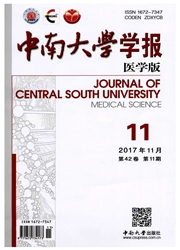

 中文摘要:
中文摘要:
目的:研究wnt5a和EB病毒潜伏膜蛋白1(Epstein-Barrviruslatentmembraneproteinl,LMPl)在鼻咽癌(nasopharyngealccmoma,NPC)癌变过程中作用的分子机制,评估其是否可作为NPC相关的分子标志物。方法:利用前期制备的NPC组织微阵列芯片,免疫组织化学检测Wnt5a和LMPl在NPC癌变过程不同组织中的蛋白表达,分析WntSa异常激活和LMPl蛋白过表达在NPC发生发展中的作用及其与NPC临床病理特征的关系,评估其是否可作为鉴别鼻咽良恶性病变的分子标志物。结果:WntSa和LMPl蛋白在NPC中的阳性表达率显著高于异型增生鼻咽上皮、增生鼻咽上皮和正常鼻咽上皮(P〈0.05,P〈0.01,P〈0.01);异型增生鼻咽上皮中的WntSa和LMPl蛋白阳性表达率也显著高于增生鼻咽上皮和正常鼻咽上皮(P〈0.05,P〈0.01)。WntSa蛋白和LMPl蛋白在临床Ⅲ和Ⅳ期NPC组织中的阳性表达率显著高于临床Ⅰ和Ⅱ期(P〈0.01,P〈0.05),有淋巴结转移的NPC组织中WntSa蛋白阳性表达率也显著高于无淋巴结转移NPC组织(P〈0.01),非角化性NPC组织LMPl蛋白阳性表达显著高于未分化癌和角化性癌(P〈0.05,P〈0.05);NPC组织中WntSa与LMPl蛋白的阳性表达存在显著正相关性(r=0.354,P〈0.001)。LMPl和WntSa蛋白联合表达检测有助于鼻咽良恶性病变的鉴别。结论:NPC组织中Wnt5a和LMPl的表达存在显著正相关,两者可能共同或相继促进鼻咽上皮细胞的恶性转化和NPC的发生发展;联合应用LMPl和WntSa可作为NPC鉴别诊断的较好分子标志物。
 英文摘要:
英文摘要:
Objective: To investigate the molecular mechanism of WntSa and Epstein-Barr virus latent membrane protein 1 (LMP1) aberrant expression in the nasopharyngeal carcinogenesis and to estimate if it can act as a molecular marker for nasopharyngeal cancer (NPC). Methods: Immunohistochemistry combined with previously made tissue microarrays were used to study the expression of WntSa and LMP1 in the nasopharyngeal carcinogenesis tissues. Weinvestigated the role of over expression of WntSa and LMP1 in the development and progression of NPC and their relation with the clinicopathological features of NPC and whether they could act as molecular markers in benign and malignant NPC. Results: The positive percentage of WntSa and LMP1 protein expression in the NPC was significantly increased as compared with that in atypically hyperplastic nasopharyngeal epithelium, hyperplastic nasopharyngeal epithelium and histologically normal nasopharyngeal epithelium (P〈0.05, P〈0.01, and P〈0.01). WntSa and LMP 1 proteins were significantly higher in atypically hyperplastic nasopharyngeal epithelium than those in the hyperplastic nasopharyngeal epithelium and normal nasopharyngeal epithelium (P〈0.05 and P〈0.01). The positive expression of WntSa and LMP 1 proteins in clinical T3 and T4 staged NPC was higher than that in clinical T1 and T2 staged NPC (P〈0.01 and P〈0.05). The positive expression of WntSa protein in the NPC with lymph node metastasis was higher than that in the NPC without lymph node metastasis (P〈0.01). The positive percentage of LMP1 protein was significantly increased in non-keratinizing carcinoma compared with undifferentiated carcinoma and keratinizing carcinoma (P〈0.05 and P〈0.05). The expression of WntSa protein in the NPC had significant positive correlation with LMP1 (r=-0.354, P〈0.001). Combined molecular phenot)rpe of both WntSa and LMP1 expression was a good marker to distinguish NPC from non-cancerous nasopharyngeal epithelium. Conclusion: The expressio
 同期刊论文项目
同期刊论文项目
 同项目期刊论文
同项目期刊论文
 Aberrant expression of beta-catenin and E-cadherin is correlated with poor prognosis of nasopharynge
Aberrant expression of beta-catenin and E-cadherin is correlated with poor prognosis of nasopharynge 期刊信息
期刊信息
